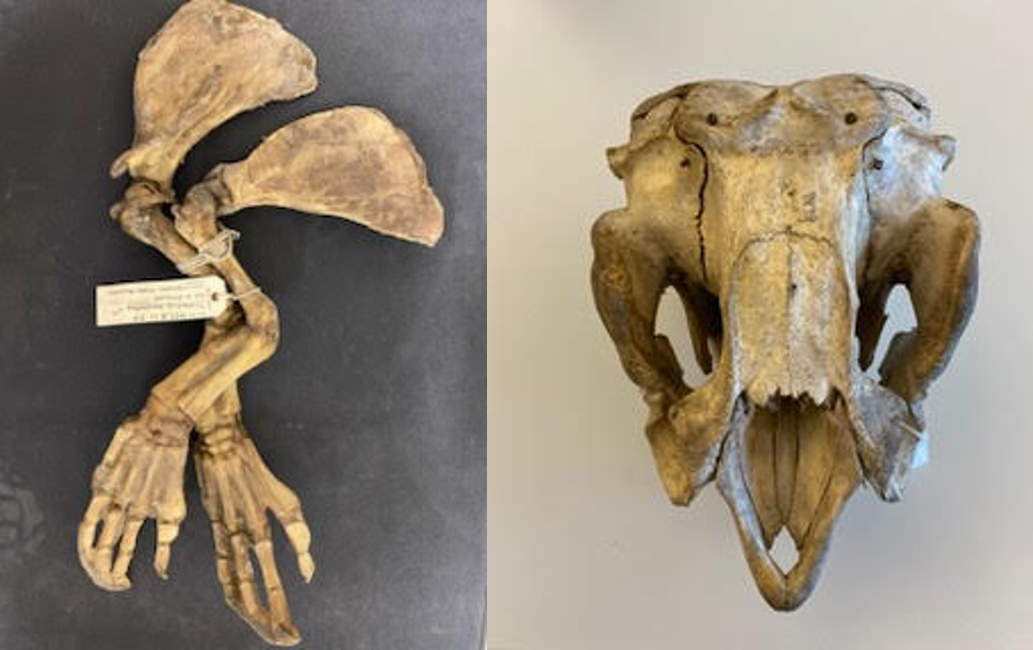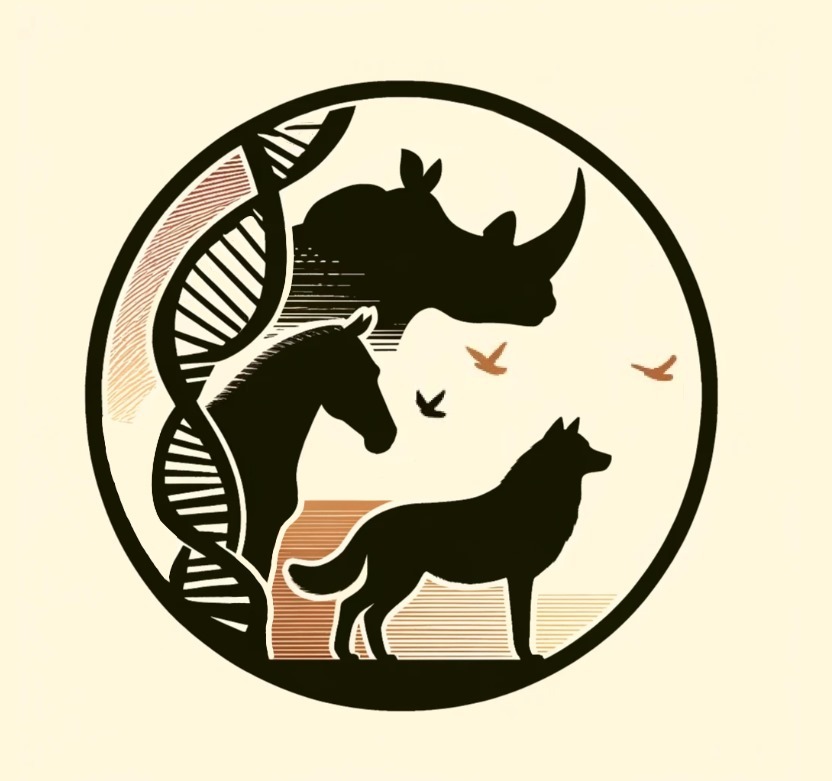March 2025
Protecting the endangered Dugong through paleogenomics
At the beginning of the XVIII century, traveler and author Ernst Christoph Barchewitz was enjoying the view from his porch near the sea shore, when he suddenly came to observe the social behavior of a pair of dugongs during his stay on Letti Islands (Maluku, Indonesia) as a commanding officer. The female of the pair was captured and killed. The male subsequently allowed himself to be killed as well:
“Once I saw two large dugongs or sea cows that came very close to the rocks by my holiday house. I quickly called my servant and showed him the sea cows as they walked around, eating the green moss that grows on the reef. […] They stung one of them, which was the female […]. When this one was caught, the other, which was the male, came of its own accord, searched for the female, did not leave, and also allowed itself to be stung; thus, they brought both to land […]. Each of these wonderful fish was over 4 meters long, but the male was somewhat larger than the female. They had heads like an ox, two large teeth a span long, and the thickness of a thumb, which protruded from their mouths, like those of wild pigs. These teeth were as white as the most beautiful ivory. The female had two breasts like a woman’s image, and the man had genitals like a man’s. Her entrails were like those of a cow, and the meat tasted like beef.” (Translated and adapted from Ernst Christoph Barchewitz, on the Island of Lethy, Newly Expanded East Indian Travel Description. Erfurt, 1791).
Contrary to Barchewitz thinking, today we know that the dugong (Dugong dugon) is not a fish but a marine mammal and one of the two extant members of the order Sirenia, which also includes the sister Trichechidae family composed by three living species of manatees [1]. The dugong is the only surviving species within the once-varied Dugongidae family, as its closest known relative, the Steller’s Sea cow (Hydrodamalis gigas), became extinct in the 1700s due to overhunting. Dugongs themselves are considered as a vulnerable species by the IUCN Red List of threatened species [2].
While manatees expand through the tropical Atlantic shores and the Amazon River, dugong’s habitat range extends across the coastal waters of around 40 nations and territories across the Indo-West Pacific region, from East Africa to Vanuatu. These animals rely heavily on seagrass for food, which confines them to shallow coastal environments where seagrass meadows thrive. They are most commonly found in sheltered locations such as bays, mangrove-lined channels, around large nearshore islands, and in waters between coral reefs. Today, the largest populations are found in northern Australian waters, especially between Shark Bay and Moreton Bay.
Given their demonstrated vulnerability and population decline due to habitat loss and hunting practices, it becomes a crucial task to analyze the state of their genetic diversity in order to inform conservation measures to prevent further genomic erosion, while also raising public awareness contributing to the preservation of these iconic marine mammals. To provide new insights into this mission, PhD research fellow Lydia Hildebrand Furness developed a comprehensive study of the past and current status of dugongs using paleogenomics techniques [3].
In her work, she got access to 76 individuals from known and major populations spanning most of their current and historical habitat range, from which 12 were historical bone specimens sampled de novo, and 64 were DNA extracts used in a prior phylogeographic study [4]. After analyzing the genetic diversity of their mitogenomes, she found five major monophyletic clades showing large geographical restrictions. Two major groups, the Western and Eastern clusters, are clearly differentiated within their mitogenomes. Among the Eastern cluster, which represents a potentially more ancient and divergent lineage, there are three well-defined related subgroups spread across Southeast Asia and Northern Australia, and an additional subcluster represented by two individuals sampled across the Indian subcontinent with less clear relationship with the other three subgroups. An increased haplotype sharing among the Western group was also found, which also showed 10-fold less genetic diversity compared to the Eastern cluster. A significant decline in effective population size of females (based on mitochondrial genomes) over the last millennium is also reported for the Western populations, which show a more recent divergence than that of the Eastern populations. As they describe, this would be indicative of a recent population expansion in the Western cluster, or the result of a population bottleneck occurred in relatively recent times.

Examples of the specimens that were sampled in the sea cow genomics project. Here are the preserved upper limbs and skull of manatees collected within the last 150 years.
Eastern populations showing deeper evolutionary divergence with strong phylogeographical structuring would support the hypothesis of an early dispersal and diversification of dugongs across the East of the Indo-Pacific region, with a possibly long-isolated and genetically distinct dugong population nearby the Indian subcontinent around the Andaman Islands, and a much more recent colonization of the Western Indian Ocean shores across East Africa. The relatively constant effective population size found across history, with only recent declines, would contradict theories about unsustainable hunting since Neolithic times [4], although further analyses on nuclear genomes might elucidate such conflicting results at greater resolution than mitogenomes might allow.
Of great concern, as our guest PhD Fellow explained, is the fact that one of the major stocks of dugongs in present days, those from the Persian Gulf population belonging to the Western clade, show the lowest genetic diversity among the analyzed subgroups5, which emphasizes the urgent need for conservation management, especially but not exclusively for Western dugong populations.
References
- Domning, D. P. Sirenian Evolution. Encyclopedia of Marine Mammals, 3rd Ed. 856–859 (Academic Press, 2018).
- Dugong dugon: Marsh, H. & Sobtzick, S. IUCN Red List of Threatened Species (2015).
- Furness, L. H. et al. Population structure of Dugong dugon across the Indo-Pacific revealed by historical mitogenomes. R Soc Open Sci 11, 240599 (2024).
- Plön, S., Thakur, V., Parr, L. & Lavery, S. D. Phylogeography of the dugong (Dugong dugon) based on historical samples identifies vulnerable Indian Ocean populations. PLoS One 14, e0219350 (2019).
- Al-Abdulrazzak, D. & Pauly, D. Reconstructing historical baselines for the Persian/Arabian Gulf Dugong, Dugong dugon (Mammalia: Sirena). Zool Middle East 63, 95–102 (2017).
Below, Lydia shared with us further details about her profile, career, prospects and future projects:
1. Briefly introduce yourself. What is your origin story for how you got into science?
I always wanted to be a marine biologist and work in scientific research. But unfortunately, my enthusiasm and grades didn’t quite align. So, I took a degree in Archaeology instead because it felt like a good intersection of my favorite subjects – history and science. I specialized in archaeological science and then did an MPhil in human evolution. Now that I work with aDNA and population genetics of marine species it feels quite cathartic.
2. How and/or why did you start working on this project?
The PhD position itself appealed to me a lot because it was very open-ended and there was a lot of space for me to curate my own project. I liked the idea of working on marine species, particularly those that have been heavily hunted and are at risk from climate change, because of the conservation angle I could bring. Primarily, it was the dramatic stories of Behring’s expeditions in the 1700s and extinction of the final Steller’s Sea cow population in the North Pacific that first drew me to this project. From here I began to explore the mythology of sea cows, the imagery created of them during the Spanish and Portuguese colonization of South America, and the record of archaeological sites with enormous bone mounds across the Indo-Pacific. This certainly captured my imagination, and from here I reached out to individuals involved in research and conservation from across the world. This led me to expand the study to cover all species within the taxon Sirenia.
3. Were there any major challenges in this project? How did you overcome them?
I had some pretty major challenges surrounding CITES in this project. CITES is a really important piece of legislation that exists to protect vulnerable and endangered species and prevent the illegal trade of wildlife. It is an international agreement whereby signatories are working together to stop unsustainable trade and protect biodiversity. It is really important that this is globally enforced. However, it can also create a lot of challenges for those who are trying to do good and honest research, such as myself. My project relied on the presence of natural history collection material, to mitigate many of the major difficulties that would exist for the sampling of live individuals from CITES protected species. Yet, I still had a lot of difficulties in obtaining this material. I spent considerable time trying to decipher a number of bureaucratic quagmire’s but ultimately was forced to turn down collaborations involving valuable archaeological and historical material from across the world. I can’t help but wonder what more this would have brought to my studies…
4. What do you think are the main take-home messages of this project?
The main take home messages from my talk Population structure of Dugong dugon across the Indo-Pacific revealed by historical mitogenomes are:
1) There is clear geographic structuring of populations across the Indo-Pacific. We see distinct monophyletic clades with different evolutionary histories; a relatively recent clade in the West, and deep-rooted and diverse clades in the East where population size is 10x greater.
2) We found a significant loss of genetic diversity in the West over recent time (since 1950). We also found that effective population size is much lower here, as well as intra-population genetic diversity.
These results add to a growing body of evidence that shows that dugong populations are significantly fragmented and becoming increasingly less genetically diverse, making them ever more susceptible to ongoing human action and global climate change. I hope that our observations will help to emphasize the urgent need for conservation management of this iconic species.
5. What do you think is missing in the field that you would like to work on?
I am a practical person so what I enjoy most is kinesthetic work. Being left to explore the cupboards of any museum is so much fun to me. So, I think that there is a lot of scope for exploring what materials, other than bone, from natural history collections can be utilized for aDNA, or more widely biomolecular, research. I tested this a bit in my PhD and got very mixed results – so I think sampling and protocol development here is an avenue that needs further exploration.
6. Where do you see yourself in the near future?
I’d hope relaxing on a beach with a cold beer and celebrating handing in my thesis. No computer in sight…
7. Free space to tell something you would like to remark.
I have no future plans to work on woolly sea cows.

